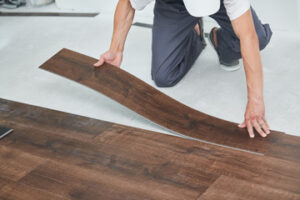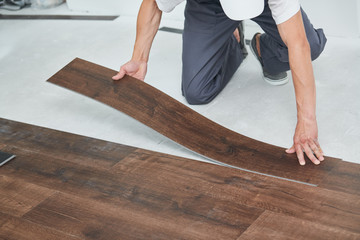Why Choose Vinyl Floors?
Vinyl floors are one of the most popular flooring options available today. They offer a combination of strength, durability, aesthetics, and cost-effectiveness. Generally made of PVC, vinyl floors offer various designs and styles. They’re also easy to install and maintain. Vinyl flooring is popular for homeowners looking for durable floors that will withstand traffic. It also looks great and is easy to care for.
 The durability of your vinyl floor depends on its thickness, which determines how well it stands up to foot traffic. Thicker vinyl provides more support and cushioning–best for high-traffic areas like kitchens and hallways. Thinner vinyl can be prone to dents and indentations from furniture legs. In these cases, you may need to install pads under your furniture legs to protect the floor from damage.
The durability of your vinyl floor depends on its thickness, which determines how well it stands up to foot traffic. Thicker vinyl provides more support and cushioning–best for high-traffic areas like kitchens and hallways. Thinner vinyl can be prone to dents and indentations from furniture legs. In these cases, you may need to install pads under your furniture legs to protect the floor from damage.
Luxury vinyl flooring is much more durable than standard vinyl, with a thicker wear layer that makes it resistant to scratches and stains. However, it is still prone to damage from heavy objects. If you have pets, luxury vinyl is more pet-friendly than hardwood floors. It is less likely to scratch or scuff, which means it won’t show the scratches from your pet’s claws as quickly. Another factor that contributes to the durability of your vinyl flooring is the quality of its materials. A low-quality vinyl can be very brittle and break easily. This can be a problem when the floor is damaged and you need to replace it.
Choosing a high-quality vinyl is important for its overall durability, and it’s also a good idea to choose a type of adhesive that will make your floor easier to maintain. A strong, fast-drying glue can help keep the floor intact for longer periods of time, while an adhesive with plasticizer-migration-resistance boosts its long-term bond integrity.
You should always buy extra vinyl planks or tiles to cover gaps in your floors if you have children or pets. This way, you can replace individual pieces if they fade.
Some types of vinyl are more prone to sun damage than others, so it’s important to shade your windows if you want to avoid fading your floor over time. Both luxury vinyl and standard sheet vinyl can fade under direct sunlight, so it’s best to draw the curtains in these rooms or use window treatments.
Vinyl flooring is one of the most popular and affordable choices for homeowners, due to its durability. It also comes with a number of features that make it easy to clean and maintain.
The floors are water-resistant and can be cleaned easily using a damp mop. However, it’s important to keep in mind that too much water can cause stains and discolorations on the surface of the floor. Therefore, it’s best to avoid soaking the floors and instead dry them with a towel after cleaning.
Regularly vacuuming your floors is a great way to maintain them. This will remove dust, hair, dirt and other debris that can accumulate over time. Moreover, using a broom regularly will ensure that your vinyl floor stays clean and free from scratches.
Another great way to maintain your vinyl flooring is by placing doormats in the entrance ways of your home. This will help prevent sand, dirt, and grit from being brought in with shoes. It will also minimize the amount of grit that gets rubbed in by people’s footsteps, which can blemish and dull your floors.
If you’re unsure about how to maintain your vinyl floor, consult a professional for advice. They can recommend the right products and techniques to use for your specific floors.
Once you have purchased the materials you need, it’s time to start a maintenance routine that will allow your vinyl floor to look its best. This includes sweeping or vacuuming your vinyl floor each evening, and wiping up any spills as soon as they occur.
For deeper cleaning, use a mop soaked in a neutral pH floor cleaner. It is also a good idea to add a little baking soda to your regular cleaning solution to help maintain the smoothness and shine of your vinyl floor.
Lastly, it’s important to avoid harsh cleaning methods that can damage your vinyl floors. Never use abrasive scrubbers or steel wool to clean your floors, as these can scratch and etch the surface of the vinyl.
To make cleaning your vinyl floors even easier, you can add a bit of soap to your regular floor cleaning solution and use it to deep clean the surfaces on a weekly basis. Alternatively, you can mix apple cider vinegar into water to create an effective floor cleaner that will safely lift dirt from the surface of your vinyl flooring.
Aesthetics are a key consideration when it comes to purchasing new flooring for your home or business. They are not only an indicator of your personal style, but they also set the tone for the space that you’re putting it in.
For instance, if you’re looking to create a modern aesthetic in your living room, vinyl planks that mimic wood are an excellent choice. Not only will they look beautiful, but they’ll also be resistant to stains and scratches.
Similarly, if you’re trying to achieve a sophisticated look in your bedroom or bathroom, opt for a luxury vinyl tile that replicates marble or stone. These types of tiles can add a luxurious touch to any room, and they’ll last for years without the need for much upkeep.
Another great way to create an impressive aesthetic with vinyl floors is to use a pattern. This will help your floor stand out, especially if you’re working with a tight budget.
There are a number of options to choose from when it comes to patterns, including high-gloss tiles with intricate geometric designs or textured patterns. Both of these options can be found in different thicknesses and can make a big difference in your home or office.
In terms of color, you can easily find a variety of colors to suit your personal taste. For example, you could go for a dark color that complements your neutral furniture or a brighter shade of blue that will pop against the white walls in your kitchen or bathroom.
You can even go with a darker color that will provide a dramatic focal point for your design. However, be sure to keep in mind that some colors can be difficult to match if you’re working with a small space or need a specific hue for your business.
The best thing about vinyl floors is that they can be made to look like any type of hard surface, from wood and stone to ceramic and more! With that said, it’s important to remember that they do not come with the same abrasion and scratch resistance that harder flooring materials do. Therefore, they should be carefully selected to ensure they do not compromise your overall comfort and safety.
Vinyl floors are an affordable and easy way to add color, style and elegance to your home. They’re also easy to clean and maintain. However, they can be prone to wear and tear, so it’s important to choose the right flooring for your needs and budget.
The price of vinyl flooring depends on the type of material and how it’s made. There are several different types of vinyl flooring, including sheet, plank and luxury vinyl tile. All of them are available in a variety of colors and patterns, but not all styles are equally affordable.
Sheet vinyl is the most inexpensive option, and it’s typically sold in 6 or 12 foot rolls. It’s a good choice for basements and other areas that are exposed to moisture. It can be installed using a glue-down method, but some people prefer the easier floating click-together option.
Luxury vinyl tile (LVT) and luxury vinyl planks (LVP) are more expensive than sheet and self-adhesive options, but they’re more durable. They’re thicker and have a wear layer that protects them from scratches. They’re also a great choice for areas that get a lot of traffic, such as kitchens or bathrooms.
There are two main ways to add color and pattern to vinyl floors: printed and inlaid. Printed flooring is created by printing the colors onto the surface of the material, while inlaid vinyl flooring uses granules of color embedded into the material.
Printed vinyl costs between $1 and $5 per square foot, while inlaid vinyl is much more expensive at between $5 and $12 per square foot. Inlaid options are generally more durable and better for high-traffic areas, but they’re also harder to install.
Another way to reduce the cost of your flooring is to shop for options that have low VOCs. These are chemicals that can be emitted by some products, which can lead to health problems in the long run.
The price of your vinyl floor will be dependent on the size of the room, the type of material used, and whether or not it’s professional installed. It’s best to shop around for the best deal before making your final decision.


